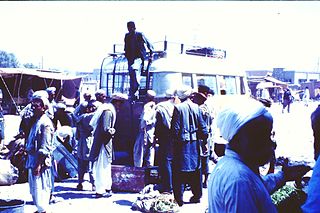
The Taliban insurgency began after the group's fall from power during the 2001 War in Afghanistan. The Taliban forces fought against the Afghan government, led by President Hamid Karzai, and later by President Ashraf Ghani, and against a US-led coalition of forces that has included all members of NATO; the 2021 Taliban offensive resulted in the collapse of the government of Ashraf Ghani. The private sector in Pakistan extends financial aid to the Taliban, contributing to their financial sustenance.
Events from the year 2007 in Afghanistan.

The 2008 Indian embassy bombing in Kabul was a suicide bomb terror attack on the Indian embassy in Kabul, Afghanistan on 7 July 2008 at 8:30 AM local time. The bombing killed 58 people and wounded 141. The suicide car bombing took place near the gates of the embassy during morning hours when officials enter the embassy.

The Haqqani network is an Afghan Islamist group, built around the family of the same name, that has used asymmetric warfare in Afghanistan to fight against Soviet forces in the 1980s, and US-led NATO forces and the Islamic Republic of Afghanistan government in the 21st century. It is recognized as a terrorist organization by the United Nations. It is considered to be a "semi-autonomous" offshoot of the Taliban. It has been most active in eastern Afghanistan and across the border in north-west Pakistan.
2003 in Afghanistan. A list of notable incidents in Afghanistan during 2003
The following lists events that happened in 2013 in Afghanistan.
The following lists events that happened during 2015 in Afghanistan.

A series of bombings in central Kabul on 7 August 2015 caused approximately 50 deaths and several hundred injuries. The attacks were ascribed to the Taliban and were the first major attacks mounted by that group since the death of their chief Mullah Omar.

The Islamic State – Khorasan Province is a regional branch of the Salafi jihadist group Islamic State (IS) active in South-Central Asia, primarily Afghanistan and Pakistan. ISIS–K seeks to destabilize and replace current governments within historic Khorasan region with the goal of establishing a caliphate across South and Central Asia, governed under a strict interpretation of Islamic sharia law, which they plan to expand beyond the region.
The following lists events that happened during 2016 in Afghanistan.

On June 20, 2016, at around 0600 AFT, a suicide bombing attack claimed to be conducted by the Taliban or the Islamic State in Khorasan Province (IS-KP) hit a convoy of Canadian embassy security guards en route to the embassy in Kabul. The attack took place in the ninth police district in the Benayi area, Kabul, Afghanistan. Thirteen Nepalese and two Indian contractors were killed in the attack.
Events in the year 2017 in Afghanistan.

The Islamic State–Taliban conflict is an ongoing insurgency by the Islamic State Khorasan Province (IS-KP) against the Taliban regime in Afghanistan. The conflict initially began when both operated as rival insurgent groups in Nangarhar; since the rise of the Taliban's state in 2021, IS-KP have targeted and assassinated Taliban members using hit-and-run tactics. The group have also caused incidents and attacks across the border in Pakistan.
On 1 July 2019, a combined gun and bomb attack took place in the Wazir Akbar Khan neighborhood of Kabul, Afghanistan. The attackers initially detonated a bomb-laden truck, after which five gunmen entered a nearby building under construction and fired on Afghan security personnel evacuating people onto the street. At least forty-five were killed, including the five attackers. The spokesman for the Afghan Ministry of Public Health, Wahidullah Mayar, said that 116 civilians, including 26 children and 5 women, were wounded. The Taliban claimed the responsibility for the bomb attack in Kabul and said although civilians were not the Taliban target, some were injured.
Ahmad Zia Saraj was final Director General of NDS from 2019 to 2021, until the collapse of the Islamic Republic. He served as the Deputy Director General, chief of counter terrorism department, deputy chief of foreign intelligence & counterintelligence and some other key positions in NDS respectively over 20 years after the fall of Taliban in 2001. He serves as visiting professor in the war studies department of the King's College London University.
In May 2020, a series of insurgent attacks took place in Afghanistan, starting when the Taliban killed 20 Afghan soldiers and wounded 29 others in Zari, Balkh and Grishk, Helmand on 1 and 3 May, respectively. On 12 May, a hospital's maternity ward in Kabul and a funeral in Kuz Kunar (Khewa), Nangarhar were attacked, resulting in the deaths of 56 people and injuries of 148 others, including newborn babies, mothers, nurses, and mourners. ISIL–KP claimed responsibility for the funeral bombing, but no insurgent group claimed responsibility for the hospital shooting.
On 2 November 2020, three gunmen stormed the campus of Kabul University in Kabul, Afghanistan, killing 32 people and wounding 50 others. The attack began around the time that government officials were expected to arrive at the campus for the opening of an Iranian book fair. The three gunmen were later killed during a fight with security forces. The attack occurred at around 11:00 A.M. The Islamic State of Iraq and the Levant – Khorasan Province (ISIL-KP) claimed responsibility for the attack.
A suicide bombing took place at Hamid Karzai International Airport in Kabul, Afghanistan, on 26 August 2021, at 17:50 local time, during the evacuation from Afghanistan. At least 183 people were killed, including 170 Afghan civilians and 13 members of the United States military, the first American military casualties in the War in Afghanistan since February 2020. The Islamic State – Khorasan Province (ISIS–K) claimed responsibility for the attack.







